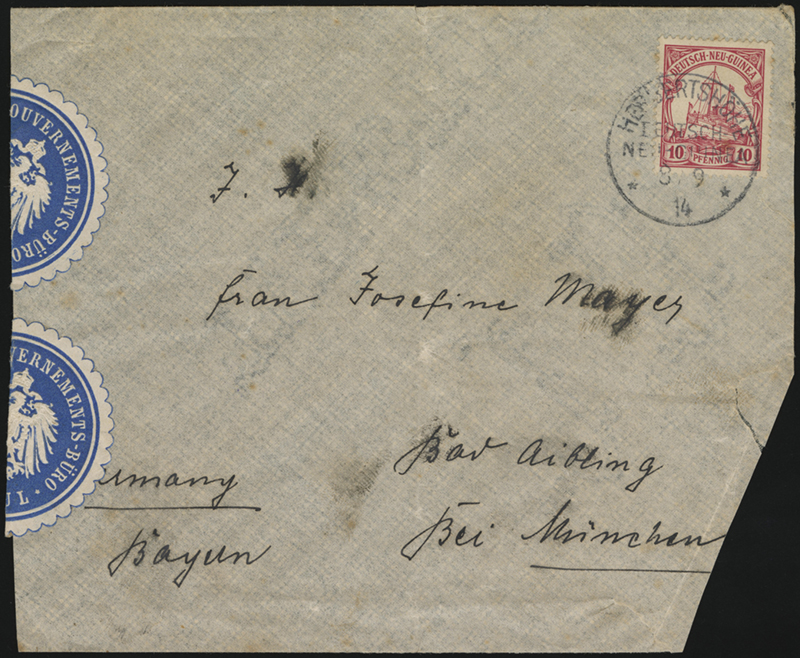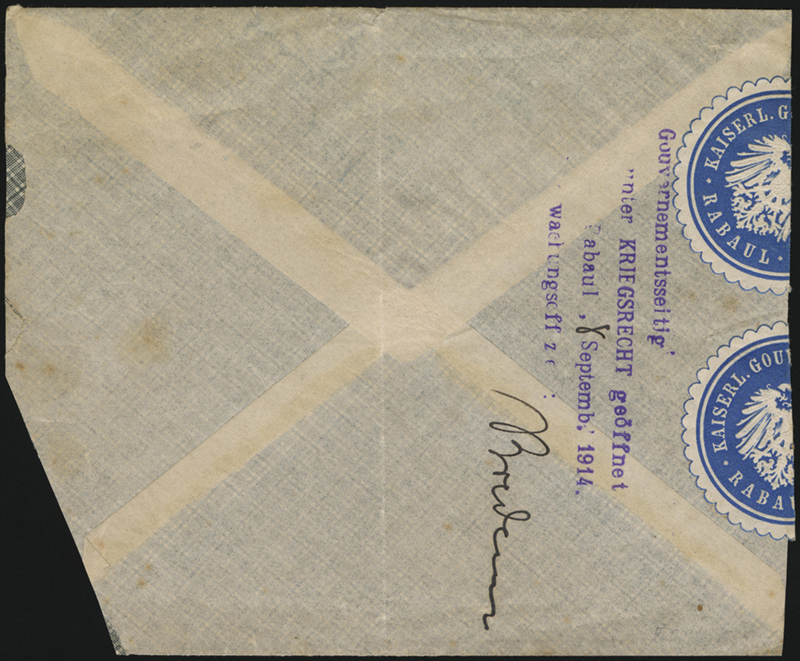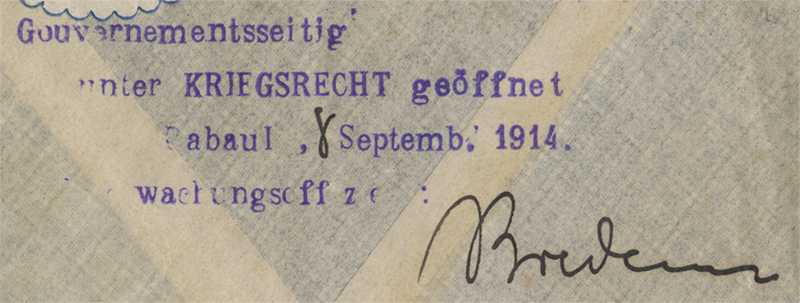German New Guinea War Mail, September 1914
May 4, 2023 21:56:41 GMT -5
kacyds, Gordon Lee, and 3 more like this
Post by PostmasterGS on May 4, 2023 21:56:41 GMT -5
Here's a rare one that arrived today.
As usual, let's set the scene first.
During the German colonial period (1880s to 1914), mail to and from German New Guinea was relatively infrequent. All mail was transported via steamer, with some being routed through steamer lines traveling all the way to Germany, and some being routed through German connections in China to the Russian Trans-Siberian Railroad.
Upon the outbreak of WWI in July 1914, all of these routes became unavailable. Traffic through Russia was no longer an option, and British control of the seas killed the sea routes. The only options left were individual steamers either attempting to make the perilous run to Germany, or in most cases, making for the nearest neutral port where the German steamers could seek refuge and forward the mail through neutral routes.
On 12 August 1914, an Australian naval force from the HMAS Warrego came ashore at Rabaul and Herbertshöhe and destroyed the telephones in both post offices. They remained until September, but then left on another assignment, giving the Germans at Rabaul and Herbertshöhe a chance to assemble accumulated mail for a mail run. Mail accumulated during August-September 1914 at Rabaul and Herbertshöhe was placed aboard the steamer Kalili, a private steamer of the Kalili Company, which was to make a run for the Netherlands East Indies. This would be the last mail run from Rabaul or Herbertshöhe prior to occupation.
As there was now a war on, all mail had to be censored. This was done by one of three officers, Herr Toelke, Herr Weber, or Dr. Bredemann. The censor markings are either manuscript markings or a rubber handstamp stating:
These censor marks are typically dated 7 or 8 September 1914. The Kalili left on 10 September 1914, just one day before Australian forces returned for good.
Kalili made an unannounced/unscheduled stop at Maron on 14-15 September 1914 to pickup additional mail from that post office, then made for Makassar, Netherlands East Indies, arriving on 1 October 1914. From there, the mail was transported through neutral channels to Germany, arriving in Frankfurt on 15 November 1914.
This piece was cancelled in Herbertshöhe on 8 September 1914, and received a handstamped censor mark from Dr. Bredemann the same day.



As it was a cover, it had to be opened for inspection. It was re-sealed with blue circular Rabaul Official Seal labels.
As usual, let's set the scene first.
During the German colonial period (1880s to 1914), mail to and from German New Guinea was relatively infrequent. All mail was transported via steamer, with some being routed through steamer lines traveling all the way to Germany, and some being routed through German connections in China to the Russian Trans-Siberian Railroad.
Upon the outbreak of WWI in July 1914, all of these routes became unavailable. Traffic through Russia was no longer an option, and British control of the seas killed the sea routes. The only options left were individual steamers either attempting to make the perilous run to Germany, or in most cases, making for the nearest neutral port where the German steamers could seek refuge and forward the mail through neutral routes.
On 12 August 1914, an Australian naval force from the HMAS Warrego came ashore at Rabaul and Herbertshöhe and destroyed the telephones in both post offices. They remained until September, but then left on another assignment, giving the Germans at Rabaul and Herbertshöhe a chance to assemble accumulated mail for a mail run. Mail accumulated during August-September 1914 at Rabaul and Herbertshöhe was placed aboard the steamer Kalili, a private steamer of the Kalili Company, which was to make a run for the Netherlands East Indies. This would be the last mail run from Rabaul or Herbertshöhe prior to occupation.
As there was now a war on, all mail had to be censored. This was done by one of three officers, Herr Toelke, Herr Weber, or Dr. Bredemann. The censor markings are either manuscript markings or a rubber handstamp stating:
“Gouvernementsseitig / unter KRIEGSRECHT geoffnet / Rabaul, __ Septemb. 1914. / Uberwachungsoffizier:”
(Opened by the government under martial law, Rabaul, __ September 1914. Censoring officer:)
(Opened by the government under martial law, Rabaul, __ September 1914. Censoring officer:)
These censor marks are typically dated 7 or 8 September 1914. The Kalili left on 10 September 1914, just one day before Australian forces returned for good.
Kalili made an unannounced/unscheduled stop at Maron on 14-15 September 1914 to pickup additional mail from that post office, then made for Makassar, Netherlands East Indies, arriving on 1 October 1914. From there, the mail was transported through neutral channels to Germany, arriving in Frankfurt on 15 November 1914.
This piece was cancelled in Herbertshöhe on 8 September 1914, and received a handstamped censor mark from Dr. Bredemann the same day.



As it was a cover, it had to be opened for inspection. It was re-sealed with blue circular Rabaul Official Seal labels.





